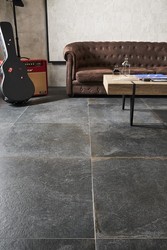Differences between tiles and porcelain
In this post we are going to explain the differences between a tile and a porcelain tile, where and how each of them should be used, their characteristics and average price.
But We are also going to disprove other myths that exist in the construction sector such as:
What is the difference between bathroom tiles and ceramic tiles? for kitchen? Why do we distinguish between indoor and outdoor floors? o How to lay a rectified tile without a joint.
How a tile differs from a porcelain tile.
Although many people believe that it is the same and many online searches are do with the term porcelain tiles, you must know the differences to know what use and resistance each one can provide.
Ceramic is a very broad concept and we not only distinguish between tiles and porcelain. Rather, within the tile there are different possibilities such as rectified tiles or white-paste and red-paste tiles.
On the other hand, within porcelain floors there are also rectified and non-rectified tiles , indoor flooring and outdoor porcelain stoneware, 20mm porcelain floors and many more.
The tiles can only be used as wall covering. Moreover, it is only recommended to place it on interior walls, bathrooms or kitchens. In case of placing a tile as an exterior wall covering, you must make sure that the climate in the area is reasonably stable, with moderate temperatures and above all that frost is not expected during winter.
On the other hand , the ceramic tile can only be used on the wall because it is not prepared to support the transit of people, furniture or machinery. And although it would not happen the first day, with the passage of time and with use it would be very likely that some tiles would begin to break.
Porcelain stoneware, on the other hand, can be placed both on terrace floors and on house floors. Of course you can also use porcelain tile on the walls.
Porcelain stoneware is still a much more resistant material than tile, withstanding both extreme temperatures and high traffic without suffering deterioration.
< p>However, the resistance of porcelain tiles is often a double-edged sword. Since its hardness often makes it difficult to handle and cut. It is necessary to have professional and quality tools to place a porcelain floor tile, otherwise you will find it difficult to cut the pieces and it can even break where it should not.That is why it is not recommended to place porcelain tile on the bathroom wall. The tile is completely suitable for this use, and in this way we will facilitate the placement of the mason. Both for cutting the tiles and for drilling them to place bathroom accessories.

The only difference by which we and most tile stores distinguish between outdoor terrace floors and indoor floors is the degree of non-slip that it has.
A porcelain tile meets the characteristics Enough to use as outdoor paving or as home flooring. If we only looked at the hardness of the material, we could group the porcelain floors in the same catalog.
It is not strictly necessary to buy a non-slip floor for the terrace or that the flooring inside the house is not non-slip. As always there are exceptions.
It is possible that you have a covered terrace, or that the tiles that you have to choose are not for around the pool. You may want them to cover the floor of a terrace in a house that does not have a slope, or that is in a city where it rains a few days a year.
If that is the case, all you have to do is buy a matt porcelain tiles, much easier to clean than non-slip flooring.
On the contrary, you have probably decided to renovate your bathroom with a built-in shower tray and you are looking for a floor to put in the shower . In this case, it would be important to use porcelain stoneware that does not slip.
This is one of the myths we come across the most. And it is nothing more than the belief that you can lay a tile without a joint.
Rectifying a tile means that the edge remains at 90º, and thus we eliminate the bevel that Once the tiles are manufactured, they have that small edge on the sides that the old tiles had.
This is true, it allows you to leave less space between tiles, but you can never put the rectified tile without a joint. separation.
Buildings suffer settlements or movements imperceptible to us, but important enough to displace some structures. The minimum 1 mm joint between rectified tiles is essential so that the tiles do not break over time.
These movements we are talking about are especially conditioned by changes in temperature . For this reason the separation between tiles must be much greater in outdoor spaces.
On terraces it is recommended to leave a minimum joint of 5mm between tiles and place an expansion joint every 20 or 30 meters.





Our customers trust us
Opinions of our clients
Receive our news